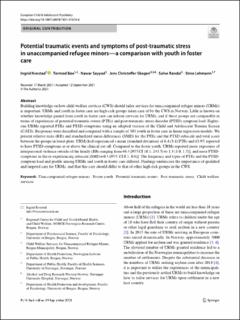Potential traumatic events and symptoms of post‑traumatic stress in unaccompanied refugee minors—a comparison with youth in foster care
Kvestad, Ingrid; Bøe, Tormod; Sayyad, Nawar; Skogen, Jens Christoffer; Randal, Sølve Bjørn; Lehmann, Stine
Journal article, Peer reviewed
Published version

Åpne
Permanent lenke
https://hdl.handle.net/11250/2783995Utgivelsesdato
2021Metadata
Vis full innførselSamlinger
Sammendrag
Building knowledge on how child welfare services (CWS) should tailor services for unaccompanied refugee minors (URMs) is important. URMs and youth in foster care are high-risk groups taken care of by the CWS in Norway. Little is known on whether knowledge gained from youth in foster care can inform services for URMs, and if these groups are comparable in terms of experiences of potential traumatic events (PTEs) and post-traumatic stress disorder (PTSD) symptom load. Eighty-one URMs reported PTEs and PTSD-symptoms using an adapted version of the Child and Adolescent Trauma Screen (CATS). Responses were described and compared with a sample of 303 youth in foster care in linear regression models. We present relative risks (RR) and standardized mean differences (SMD) for the PTEs and the PTSD subscale and total score between the groups in forest plots. URMs had experienced a mean (standard deviation) of 6.4 (3.4) PTEs and 43.9% reported to have PTSD-symptoms at or above the clinical cut off. Compared to the foster youth, URMs reported more exposures of interpersonal violence outside of the family (RRs ranging from 66.4 [95%CI 18.1; 243.5) to 1.3 (1.0, 1.5)], and more PTSD-symptoms in the re-experiencing subscale [SMD = 0.3 (95% CI 0.1, 0.6)]. The frequency and types of PTEs and the PTSD-symptom load and profile among URMs and youth in foster care differed. Findings underscore the importance of qualified and targeted care for URMs, and that this care should differ to that of other high-risk groups in the CWS.
